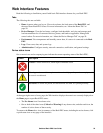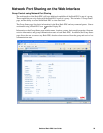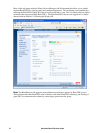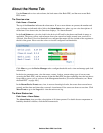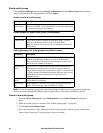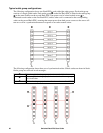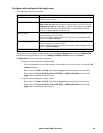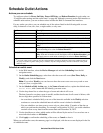62Switched Rack PDU User Guide
Purpose and benefits of outlet groups
By using groups of synchronized outlets on Rack PDUs, you can ensure that outlets turn on, turn off, and
reboot in a synchronized manner. Synchronizing control group actions through outlet groups provides
the following benefits.
• Synchronized shutdown and startup of the power supplies of dual-corded servers prevents
erroneous reporting of power supply failures during a planned system shutdown or reboot.
• Synchronizing outlets by using outlet groups provides more precise shutdown and restart timing
than relying on the delay periods of individual outlets.
• A global outlet is visible to the user interface of any Rack PDU to which it is linked.
System requirements for outlet groups
To set up and use synchronized outlet control groups:
• You need a computer that can initiate synchronized control operations through the Web interface
or command line interface of the Rack PDUs or through SNMP.
• All of the Rack PDUs must use firmware that has the same version number for both the APC
Operating System (AOS) module and the application module.
• All of the Rack PDUs must be configured with the same “Member Name”.
• If you are using Network mode, you will also need the following items. These are not necessary if
you are using Network Port Sharing mode over the In/Out ports.
– You need a 10/100Base-T TCP/IP network, with an Ethernet hub or switch that has a power
source not shared by the computers or other devices being synchronized.
– All of the Rack PDUs must be on the same subnet.
– Outlet groups you synchronize must have the same Multicast IP address, outlet group port,
authentication phrase, and encryption phrase. Make sure each Ethernet switch that connects
Rack PDUs allows Multicast network traffic for that Multicast IP address.
Rules for configuring outlet groups
For a system that uses outlet groups, the following rules apply:
• A Rack PDU can have more than one outlet group, but an outlet can belong to only one outlet
group.
• A local outlet group, which has no global outlet, must consist of two or more outlets.
• You can synchronize a global outlet group on one Rack PDU with a global outlet group on each of
three other Rack PDUs.
– In a global outlet group, you can designate only one outlet to be a global outlet, linking to
outlet groups on other Rack PDUs for the purpose of synchronization. That global outlet can
be the only outlet in its group, or the group can consist of multiple outlets.
– A global outlet of one outlet group must have the same physical outlet number as the global
outlet of any other outlet group to which it links.
• To create and configure outlet groups, you must use the Web interface or export configuration file
(.ini file) settings from a configured Rack PDU. The command line interface lets you display
whether an outlet is a member of an outlet group and lets you apply control actions to an outlet
group, but the command line interface does not let you set up or configure an outlet group.



